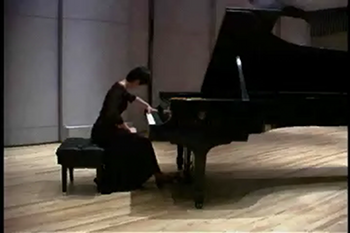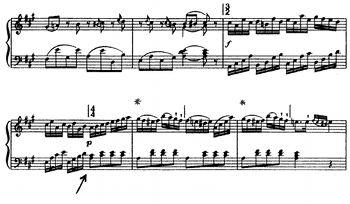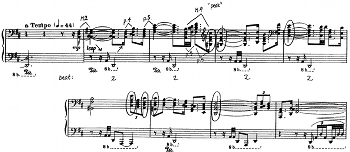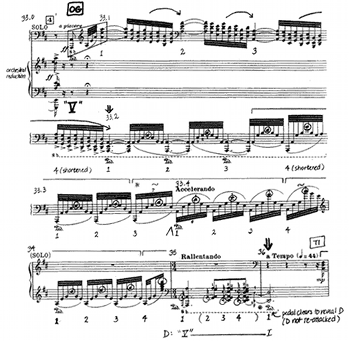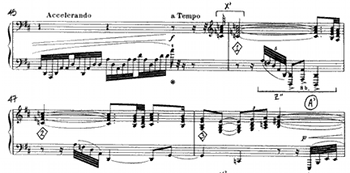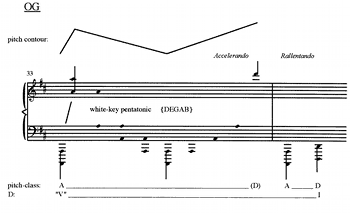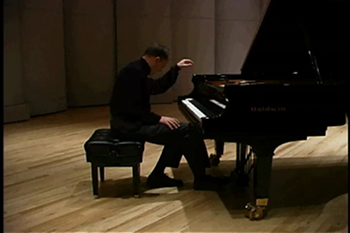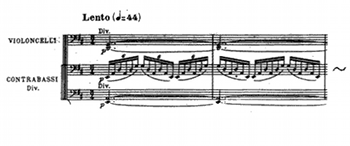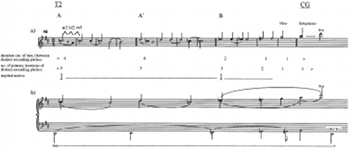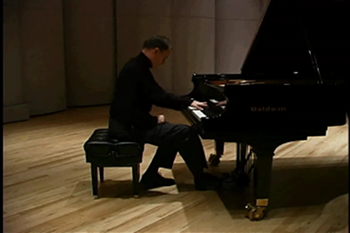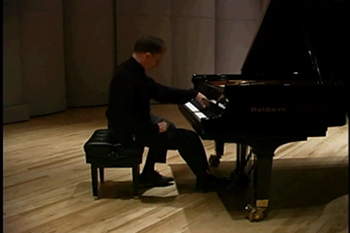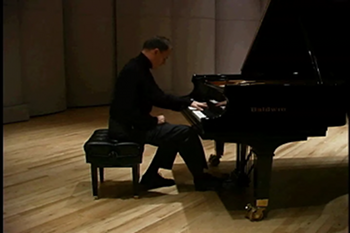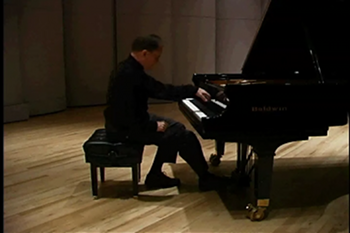The Performer’s Voice: Performance and Analysis in Ravel’s Concerto pour la main gauche *
Daphne Leong and David Korevaar
KEYWORDS: Ravel, concerto, cadenza, performance, performer, analysis, recording, rhythm
Copyright © 2005 Society for Music Theory
[1] Janet Schmalfeldt, in her ground-breaking article “On the Relation of Analysis to Performance” (1985, 2), challenges analysts to develop “a comprehensive critique of the value and the limitations of analysis for performance.” We wish to turn this goal on its head: to explore the value and limitations of performance for analysis. What can a performer’s voice contribute to the analysis of a work?
[2] We take the opening cadenza of Ravel’s Concerto for the Left Hand (Video 1) as a case study.(1) Certain performance considerations—technical, visual, and affective elements—comprise warp and weft not only of the Concerto’s execution and interpretation, but also of its structure and meaning. In addition, we are able to speak both from personal experiences of having performed the Concerto and from insights provided by historical recordings of the work.
[3] After a brief overview of literature on performance and analysis, we explore the cadenza: visual and kinesthetic aspects, rhetorical and tonal function, form and structure, rhythmic features and performance issues.
* * *
[4] The words “analysis” and “performance” have wide purviews: “performance” may refer to live performances, recordings, sight-reading, practice, memorization, improvisation, historical practices, events of performance, and to aesthetic, hermeneutic, social, psychological, cognitive, or motor aspects of the foregoing. “Analysis” might examine style, score, performance, or historical figures, and might take approaches from domains of musicology, music theory, psychology, pedagogy, performance, and so on. Our discussion of “performance and analysis” centers on analysis and performance as related to particular works.
[5] Since the time of Schmalfeldt’s article, the literature on performance and analysis has burgeoned dramatically, in two primary directions. The first presents analyses and their implications for performance, and the second studies performances (usually sound or video recordings).
[6] In the first category, the balance is weighted towards “analysis,” with “analysis” coming prior to “performance” in both time and importance. The most common scenario features analysis of certain structural elements, followed by suggestions for how these analytical observations might be interpreted in performance. Even Schmalfeldt’s article, in which “analyst” and “performer” interchange roles of presenter/responder, has the “performer” receiving “answers” from the “analyst”—not vice versa.(2)
[7] This prioritizing of analysis means that the analyst must first ask what types of analysis have a bearing on performance. And indeed, this is a question raised, implicitly or explicitly, by many “performance and analysis” articles. Most suggest or state that elements of design (rhythm, motive, form) and surface-level structure translate directly into performance, while deeper-level structure informs performance decisions indirectly, if at all.
Example 1. Mid-bar downbeat in J.S. Bach French Suite No. 5 in G major, Gigue, mm. 1–2, 14–16
(Burkhart 1994, 18)
(click to enlarge)
Example 2. Mid-bar downbeat in Mozart Sonata K. 331, I
(Cone 1968, 44)
(click to enlarge)
Example 3. Motivic parallelism in Beethoven Sonata Op. 7, III
(Burkhart 1983, 100-01)
(click to enlarge)
[8] Some examples of the first category follow. “Mid-bar downbeats” in Bach’s keyboard works necessitate specific performance decisions, according to Charles Burkhart (1994). One example of such a mid-bar downbeat is shown in Example 1, measure 14; this example shows a mid-bar downbeat that almost performs itself, due to the metric identity of the Gigue subject. Example 2, from Edward T. Cone’s Musical Form and Musical Performance (1968), shows a clear mid-bar downbeat in the first movement of Mozart’s Sonata K.331.(3) A performer may elect to bring out this metric shift, or to “play the barlines,” as Alicia de Larrocha does in her 1990 recording of the sonata.(4)
[9] Rhythm provides a fertile field for “performable” analysis. Other rhythmic constructs applied to performance include extended upbeat/structural downbeat (Berry 1988 on the final movement of Beethoven’s Eroica Symphony), phrase overlaps (Rothstein 1989 on Chopin’s Mazurka Op. 6 No.1), and other features of hypermetric or phrase structure.
[10] A related domain, formal design, also falls into the “performable” category. Relevant elements range from smaller- to larger-scale features. Motivic parallelism, in particular, suggests many interpretive nuances. Example 3a shows a motivic parallelism from Beethoven’s Sonata Op.7, and the articulative break that it suggests (Example 3b).(5) On a larger scale, Schmalfeldt’s (1985) performance interpretation of Beethoven’s Bagatelle Op.126 No.5 rests on a reading of form.
[11]
Surface-level or middleground voice-leading, such as that discussed by Burkhart
(1983, 105–112) in the Sarabande from Bach’s Partita in
[12] One can postulate several reasons for the rough correlation between closeness to the surface and applicability to performance decisions. Perhaps the most obvious is that the background influences global interpretive decisions—broad questions of direction and shaping difficult to articulate in the form of precise performance directives. A second reason may be that performance concerns itself primarily with expressing unique and unusual elements, with how the background is expressed through middleground and foreground, rather than with the background per se. And finally, and most speculatively, perhaps background structure is robust: it is expressed in all but the most idiosyncratic performances, whereas the existence of more surface-level structures depends to some extent on how they are or are not performed.
[13] So the first category of “analysis and performance” writings relates analysis to performance, tying rhythm, motive, form, and foreground and middleground features to interpretive suggestions. The second category approaches “performance and analysis” from the opposite direction by analyzing performances. Methodologies tend to be primarily empirical or primarily qualitative.
[14] Empirically-oriented studies analyze specific performed parameters (timing, dynamics, intonation, physical motion, timbre, etc.) and filter them through interpretive parameters such as musical structure, musical meaning, listeners’ reactions, and artificial models of performance. Data sources range from constructed experiments to actual rehearsals/performances to commercially-released recordings. On occasion, analysis of empirical data is supplemented by analysis of performers’ commentary, or interpreted in view of historical and cultural context.(6)
[15] More qualitative approaches explore a wider range of parameters—expressive articulation, musical gesture, affect, etc.—in a more holistic fashion. Findings are compared to score analysis, interpreted using semiotic tools, placed in the context of performance traditions or a specific performer’s aesthetic, and so on.(7)
[16] Both analysis of the score, and analysis of performances, however, beg two basic questions: What is being analyzed? And who is doing the analyzing? With rare exceptions, existing analytical literature on performance studies texts: the score, recorded performances or experimental sessions, or even recorded performers’ interviews or commentaries. Performers, when included, are usually objects of study; rarely do they have a voice in the research that is produced.(8)
[17] This is a glaring omission, with serious consequences. Apart from the obvious issue of “who knows the most about performance, anyway?” music-theoretic literature on performance and analysis neglects an integral aspect of performance: works as “something that you do” (Cusick 1994, 18).(9) It neglects, in other words, performers’ implicit analyses and the gloriously messy aspects of a work as an activity, involving score, aural, visual, and kinesthetic aspects.(10)
[18] For good reason: music-theoretic discourse admits messiness grudgingly, if at all. And performers are culturally “outside” the music-theory community. Unless invited, they cannot participate in the discussion (nor may they wish to, particularly if the price of admission is “music-theory speak”!).(11) But “analysis and performance” suffers as a result.
[19] This article is co-authored by a theorist-pianist (DL) and a performing and teaching concert pianist (DK). We believe that our combined perspectives enrich an “analysis and performance” discussion by granting “purely performance” issues a place at the analytic table. Our hope is that “purely analytical” questions might gain from performance insights, as well as the other way around.
[20] In order to complement our individual perspectives as pianists, we also explore historical recordings of Ravel’s Concerto. Appendix 1 lists recorded performances of the Concerto by pianists with some association with Ravel: Jacqueline Blancard, Robert Casadesus, Alfred Cortot, Jacques Février, Vlado Perlemuter, and Paul Wittgenstein.(12) The recordings are of interest because of their connection, however tenuous, with the composer.(13) Asterisks indicate those recordings to which we have had access, and to which we refer in the following analysis. Information on each pianist and his/her connection with Ravel is given at the bottom of the table.
* * *
[21]
On a fundamental level, the physical in this Concerto constrains the structural.
Maurice Ravel felt that “the music of a Concerto
[22] The Concerto’s left-handedness is essential. Ravel’s disapproval of Alfred Cortot’s two-handed rendition (Orenstein 1990, 327) suggests as much, for the concerto exploits and stretches to their limits the possibilities of this single hand.
[23]
In an essay entitled “Ravel ou l’esthétique de l’imposture” (Ravel or the
Aesthetic of Imposture), Ravel’s student and biographer Roland-Manuel states
that “il ne procède pas habituellement par métaphores,
Example 4. Ravel, Concerto pour la main gauche, opening cadenza: m. 57.1
(click to enlarge and watch video)
Example 5. Ravel, Concerto pour la main gauche, opening cadenza: Theme I (mm. 36–44)
(click to enlarge and watch video)
[24] To no one is this more evident than to the performer. Example 4 shows the left hand leaping between two lines, playing the roles of two hands and maintaining the illusion of two contrapuntal lines.
[25] Example 5 displays one instance of the concerto’s first theme. This example provides several illustrations of the left hand’s multiple roles. The performer must give the illusion of a legato singing line with the use of thumb-only on the melody. A true legato is impossible using only one finger; this legato line is made even more impracticable by the left hand’s leaps to the bass register. The passage is further complicated by accompanying harmonies too wide for the average hand (circled); these chords must often be split.
[26] Yet Ravel also endows the passage with characteristics true to the left hand. The thumb-only melody exploits the thumb’s ability to produce a rich full tone. The theme’s casting for one finger alone heightens the performer’s sense of the expanding leaps leading to the peak of the melody. And the physical motion between melody on beats one and three, and sarabande-like bass on beat two, creates a palpable rhythmic “groove.”(15)
[27] These parallels and conflicts between physical and musical narratives create meaning for the performer, and, in so far as the (in)congruences are displayed, for the audience member as well.(16) In the Vivo passage of the earlier Example 4, the visual contrast between physical motion and linear strands contributes to the drama of the passage. As the distance between the two contrapuntal strands increases, so does the physical demand on the performer and the visual drama for the audience member. Other (in)congruences, however—the illusory (one-fingered) legato and split chords of Example 5—should be concealed.
[28] The physical and visual omission of the right hand brings aesthetic issues—“unusualness” and the challenge of limitation—into play. An analysis of the “text” of this concerto—the score or its aural representation—would surely bypass what lies at its heart: the left hand’s immensely successful portrayal of two hands at work.(17)
Overview of the Cadenza
Example 7 (a-b). Ravel, Concerto pour la main gauche, opening cadenza
(click to enlarge)
Example 7(c-d). Ravel, Concerto pour la main gauche, opening cadenza (continued)
(click to enlarge)
Example 8. Comparison of Opening and Closing Gestures (OG, CG) in Ravel, Concerto pour la main gauche, opening cadenza
(click to enlarge)
Video 4. Example 7a, mm.35–36
(click to watch)
[29] The opening cadenza of the concerto performs the rhetorical function of announcing the soloist and establishing his/her authority: clarifying key, presenting and transforming thematic material, and establishing a wide keyboard range. The cadenza provides striking proof of the one-handed pianist’s keyboard prowess: having one hand is no handicap, since this pianist can traverse the entire keyboard and make as wide a variety of noises as any two-handed performer. (Compare this piano entrance to that in Ravel’s G-major Concerto: in the two-handed concerto, the soloist begins the piece as part of the orchestra and is initially confined to a high register.)
[30] We have divided the cadenza into four sections. (Please see Example 7, which is a continuous score of the complete cadenza. We refer to this example throughout our discussion; the reader may wish to print it out for ease of reference). With the Opening Gesture (OG) (Example 7a), the pianist announces a triumphant arrival with flourish. Then, the stage set, the soloist “sings” the lyrical Theme 1 (T1) (Example 7b), with its lush harmonies. Theme 1 transforms into the majestic and fanfare-like Theme 2 (T2) (Example 7c), featuring full dynamic, octave doublings, and double-dotting, and building to a virtuosic passage of dramatic leaps. The increasing intensity culminates with the Closing Gesture (CG) (Example 7d), comprising virtuosic scalar passages, noisy tremolandos, and a dramatic glissando.
[31] We now dissect these first impressions. OG and CG bookend the cadenza, framing its thematic content (T1, T2) with virtuosic gestures. Example 8 compares and contrasts the OG and CG. Both are predicated on pitch class A, closing with a motion to D. OG inhabits the white-key pentatonic {DEGAB} exclusively, while CG presents a combination of A Mm7 (with flat 9) and black-key pentatonic. Both OG and CG claim a large keyboard range and traverse their ranges with equivalent pitch contours: up-down-up, followed by a low register motion to D.(18) The fast initial “up” establishes the range, the slower “down” explores it in a more leisurely fashion, and the final “up” builds to the arrival of tonal center D.(19) As rhetorical gestures, OG and CG differ: since the OG presents and establishes the soloist, it unfolds more expansively and more comfortably, on the white keys, while the CG, as the culmination of tension built up through T2, is more compressed in time and more awkward, with fast black-key passagework.
[32]
Tonally, the two gestures move from dominant to tonic in D. The “V”– I motion of
the OG is shown in Example 7a, measures 35–36 (and Video 4). This arrival on the tonic D—the first of the
concerto—provides a strong sense of resolution after the harmonic ambiguity of
the preceding orchestral introduction. The resolution, however, is an
“imposture,” on three counts. First, as mentioned earlier, the OG motion from A
to D occurs entirely in a pentatonic collection {GABDE}; it thus lacks the force
and leading tone (
[33] Third, the OG’s arrival on the tonic acts merely as an interior cadence, a way-station en route to the V7 of the CG (Example 7d, measure 57.2). This long-awaited V7—the work’s first complete dominant chord—resolves to I at the orchestral reentry (measures 58–59), combining tonal resolution with timbral, thematic, and formal emphasis.(20) The result is a “structural downbeat” following on the heels of the “expanded upbeat” comprising the orchestral introduction and opening cadenza.(21) The particular nature of this structural downbeat derives from the solo piano’s materials: the orchestra’s bass D arrives late just as the piano’s bass D did in T1. The lateness mandated by the pianist’s one-hand limitation thus carries over to the orchestra, which has no such physical limitation.
[34] The underlying harmonic progression of the cadenza is thus “V”– V7 – I. The cadenza clarifies the tonal function of the preceding orchestral introduction. As shown in Example 6a, the concerto begins ambiguously, with a divisi sonority of stacked fourths {E,A,D,G} played softly by celli and double basses in their lowest registers. The sound emerges gradually, as if it has been going on for a while before the listener becomes aware of it.(22) Thematic material (not shown) emerges slowly in the contrabassoon and passes eventually to upper winds, brass, and strings. Dynamic and texture build, culminating, as shown in Example 6b, in the final chord of the orchestral introduction, a re-orchestration of the opening chord {E,A,D,G} over an E pedal (listen to Audio Example 1).
| Example 6. Ravel, Concerto pour la main gauche, orchestral introduction (click to enlarge) |
Audio Example 1. orchestral introduction—beginning and end (Charles Dutoit, Orchestre symphonique de Montréal, 1983) |
[35] The pianist’s entry, with its forthright articulation of the dominant, answers the harmonic ambiguity and timbral build-up of the orchestral introduction. It is only here that the tonal function of the orchestral introduction—supertonic—becomes clear. The entire introduction to the concerto (including the opening cadenza) articulates a large-scale supertonic-dominant-tonic progression: large blocks of pedal tones move from E (orchestral introduction) to A (cadenza’s OG and CG) to D (orchestral reentry).(23) This E–A–D motion is foreshadowed by the opening <E,A,D> arpeggio in the double basses.
Performance Considerations
Example 9. Ravel, Concerto pour la main gauche, opening cadenza: Theme 1
(click to enlarge)
Example 10. Ravel, Concerto pour la main gauche, opening cadenza: Theme 2, reduction
(click to enlarge)
Video 5. mm. 54–57.1
(click to watch)
Video 6. Example 7a, mm. 33.0–33.2
(click to watch)
Audio Example 2. Blancard 1953, measures 33.0–33.2
Audio Example 3. Février 1957, measure 33.0–3
[36] The OG and CG frame an exposition of thematic material in which the piano takes over, clarifies, and transforms themes that had first appeared in the orchestral introduction. In the pianist’s version, the two themes differ markedly in melodic vocabulary. While the first theme (Example 9) moves primarily by major second, perfect fourth, and perfect fifth, the second theme (Example 10a) focuses on minor second, major second, and minor third.(24) Since the melodies are played with the thumb only, each interval requires a corresponding arm motion, and the pianist experiences intervallic distances physically as well as aurally.(25)
[37] The cadenza brings several interrelated pianistic considerations to the fore: dynamics, pedaling, and voicing. Example 7c shows one problem in dynamics. The second theme (see especially measures 54–56) increases in dynamic as it rises in register, contradicting the piano’s properties. (The piano decreases in resonance with rising register.) Furthermore, the primary melody notes enter before their supporting bass notes, compounding the problem. The pianist must compensate for this contradiction between desired musical effect and instrumental properties by carefully rationing the crescendo; the strain of rising register and increasing dynamic also contributes to the building intensity of this passage (see Video 5).
[38] The separation of bass and melody creates a need for pedal, and the added dilemma of how to pedal. As shown in Example 7 (above), Ravel marks pedaling in OG and CG.(26) In both OG and CG, the marked pedaling reinforces the underlying pedal A. In the OG (Example 7a), for example, a single sustained pedal holds the initial bass A0–A1 through the entire opening cascade from A4–A5 back down to A0–A1. The pedal is then changed with each octave ascent so that the rising line is not lost amidst the more resonant lower sonorities. The passage’s penultimate pedal change at the return of A0–A1 (measure 35) is held until A resolves to D (measure 36).
[39] Depending on the acoustics of the hall, however, the performer may have to clear the pedal (at least partially) more often than indicated by Ravel.(27) In my performances, I (DL) aim to carry the low A0–A1 pedal through, at least conceptually. I (DK) sometimes use the piano’s middle pedal to sustain the bass A0–A1 through the first OG descent, then release it and follow the marked pedaling for the rest of the passage (see Video 6).
[40] Other performers, such as Blancard (1953) and Perlemuter (1956), do not carry the bass A0–A1 through, clearing the pedal with the arrival of each long note, or even more often. In our opinion, this detracts from the momentum and drama of the passage (listen to Audio Example 2).
[41] Février (1957) presents an entirely different conception of the OG. He pedals very little in the opening descent (measure 33.1), playing the sixty-fourth notes non-legato and at times detached. Then, rather than grouping the OG ascent (measures 33.2–34) according to the octave ascents of the bass A’s and Ravel’s pedal markings, he opts (as shown by brackets above the staff) for four-“beat” groupings initiated by the rhythmic change to constant sixty-fourth notes in the middle of measure 33.2. Février articulates the groupings by replacing Ravel’s indicated pedal changes with his own (particularly noticeable at the point marked *), accompanied with accentuation (at *) and slight pauses before the melodic B’s of the first “beat” of each group (marked with ~).(28) He thus preserves the lower octave as bass for each succeeding move upwards, and facilitates a focus on a long melodic line and forward motion. (The melodic line is circled; Février projects a continuously-rising line by correctly playing E4 at the end of measure 33.2 rather than the published G4.(29)) The overall effect is that of a continuous build-up of texture and momentum (listen to Audio Example 3).(30)
[42] In the first and second themes, a different kind of pedaling dilemma occurs. Here harmonies in the melody change above a bass line that remains static or changes at a different time than the melody. The pianist’s single hand cannot physically sustain both lines; the pedal must sustain the melody while the bass is being played, and vice versa. As a result, lifting the pedal for harmonic clarity in one line often breaks the flow of the other line.
[43] In the first theme (Example 7b), for example, pedal changes can only be made on the downbeat if notes are to be sustained as written. This follows Ravel’s pedal indications and the notated rests. However, harmonic changes in the melody occur on both beats 1 and 3, leaving the pianist with the choice of clearing the pedal partially or entirely on beat 3 and shortchanging the bass D, or holding the pedal and bass D and blurring the third beat. A third option is to pedal as indicated, voicing chords carefully with an ear to dissonance and consonance.
[44] The second theme (Example 7c) presents trickier problems.(31) In measures 47–48, for example, one cannot sustain notes as written with any degree of clarity: the only “legitimate” pedal changes occur at the rests, with a long stretch of changing harmonies in between. In general, judicious voicing lessens the need for pedal changes, but occasionally, as in this last passage, the pianist must half-pedal, or “sneak” pedals. And as with many other performance decisions, choices remain subject to the specific characteristics of piano and hall (see Video 7).
[45] Because of the registral split between melody and bass, then, pedaling acquires a structural significance. More than merely providing color and timbre, the pianist’s pedaling choices determine harmonies, lines, and gestures heard. We prefer to maintain the lines as much as possible, bringing out the melody and half-pedaling where necessary for harmonic changes. Blancard 1953 and Casadesus 1947, on the other hand, value harmonic clarity over sustaining individual lines, and clear the pedal very frequently. Wittgenstein’s (1937) pedaling neither clarifies harmonies nor sustains individual lines; he holds the pedal through rests in first and second themes, creating unnecessary blurs.
Rhythmic Considerations
[46] In De musica, Augustine writes about music as being in the realm of mind-spirit, rather than that of the body—“as disciplina and scientia, not as operatio, in which the corporeal show dominates. In operatio one is captivated by the visual input of music (or a theatrical performance) being produced before one’s eyes. In this capacity these two arts imitate and exhibit rather than seek after truth.” Augustine sees rhythmic pattern as a perceptible and rational path to this truth.(32) We will demonstrate, however, that operatio contributes to and defines rhythmic patterning in this cadenza. The first rhythmic feature we discuss, “split beats,” arises from the physical limitations of a single hand. The remaining two, iambic groupings and their transformations, and expansion/contraction, direct a performer’s sense of momentum, rhythmic contour, and affect.
[47] The single-hand nature of the work decrees that registrally-distant bass and melody be articulated separately. Thus beats “split” between melody and harmony, creating characteristic metric structures.
[48] The opening of the OG (Example 7a) illustrates a characteristic “split beat.” As shown by “beats” numbered below the staves, the passage consists of “measures” of four unequal “beats,” where the fourth “beat” is frequently shortened (measure 33.1, measure 33.2, absent in measure 33.3), providing a sense of acceleration.(33) The very first “beat” of the gesture (measure 33.1) falls in a strange place—at least one quarter note after the orchestral downbeat of measure 33.0.(34) We interpret the pianist’s low A0–A1 octave as the bass of the chord, with the top of the chord arriving at measure 33.1; the boxed notes all form part of a single verticality, broken out of physical necessity.(35) We view the entire broken chord as part of the preceding orchestral downbeat, although it must follow the orchestral downbeat so that the pianist can be heard.
Audio Example 4. Blancard 1953, measures 30–33.2
Audio Example 5. Février 1957, measures 30–33.2
[49] This “split-chord” interpretation affects the way that I (DL) play the passage. Rather than waiting for the orchestra’s final chord to die down, I come in immediately, weighting the low A, and playing the high A5–A4 as an extension of the bass A0–A1. I (DK) approach it similarly, with the feeling that the momentum of the orchestra’s cutoff leads directly into the piano gesture. Other performers’ recordings reflect various interpretations. Wittgenstein 1937, Perlemuter 1956, and Blancard 1953 wait for silence before entering (listen to Audio Example 4).(36)
[50] Blancard then lingers on the first of the ascending sixty-fourth notes, and Perlemuter “places” the top chord. Casadesus 1947 and Février 1957, on the other hand, enter immediately, Casadesus lingering on the first of the sixty-fourth notes and Février “placing” the top chord (listen to Audio Example 5).
[51]
A similar phenomenon occurs at the juncture between the pianist’s second theme
and CG. As shown by numbers in diamonds between staves in Example 7c, the second
theme expresses four-measure hypermeter, with a bass arpeggio acting as the
fourth-measure anacrusis to each hypermetric downbeat. The Vivo passage ending
the theme (measure 57.1—a “stretched” fourth measure) leads to the hypermetric
downbeat beginning the CG (Example 7d). This downbeat, articulated by the
long-awaited V7, “splits” three ways, between the bass arrival, the circled
melodic arrival on A5 (ending the large-scale melodic line <
[52] The two large split beats that we have just discussed articulate analogous points in the cadenza’s structure (the openings of OG and CG), and dramatize the cadenza’s articulation of the dominant (“V” and V7 respectively). Ravel thus parlays physical limitations into articulators of tonal middleground.
[53] Both of these cases feature bass arriving first, followed by melody. Beat “splitting” also occurs in the opposite order (melody first, harmonic filler second), as shown in Example 7a, measures 35–36. Here, the primary motion A to D is elaborated with a pentatonic descending line <A1, G1, E1, D1> (circled); the pianist attacks this line first, then fills in the upper harmonic {A,G} dyad. In contrast to this interpretation, both Wittgenstein 1937 and Blancard 1953 interpret the lower notes as literally notated—as grace notes to the upper ones.
[54] We have been describing ways in which the physical constraints of a single hand impact metric structure in the cadenza. Now we will look at two rhythmic features of the cadenza pertinent to performance: iambic groupings, and expansion/ contraction.
[55] The cadenza prominently features groupings in which metrically-weak first parts precede metrically-stressed second parts. These iambs and their transformations pervade the rhythmic structure of the cadenza at multiple levels.(38)
[56] In the lyrical first theme (Example 7b), for example, transformations of the basic iamb X = <sixteenth note, longer note (on the beat) > into successively expanded gestures Y, Z, and Z’ parallel the theme’s melodic contour and delineate its rhythmic shape. In the melody, Y highlights changes of direction in pitch contour, preceding both the arrival at the melodic peak (measure 38) and a departure from a strictly descending contour (measure 40); in the bass, Y (measure 39) and Z (measure 41) follow these two points. Z and Z’ contribute to the theme’s expansion, preceding expansive melodic echoes, and, in the process, influencing transformation of the melodic iambic pattern <sixteenth, dotted eighth, sixteenth, long> into triplet eighth notes(39) and “delaying” the melodic long note that would normally occur on the downbeat. In short, successive expansion of iamb X into Y, Z, and Z’ undergirds a performer’s sense of the theme’s expansion.
[57] The second theme (Example 7c) takes over much of the rhythmic structure of the first (iambic patterns, second-beat accompaniment, specific rhythmic motives), but transforms it to communicate a dramatically different affect. It sharpens iamb X = <sixteenth, long> to X’ = <32nd, long>, and transforms Z’ into the dramatic descending flourish of Z”. These transformations, combined with octave doublings, expanded register, and arpeggiated sweeps, contribute to the majestic and powerful character of this second-theme presentation.(40)
[58] In his 1939 recording, Alfred Cortot conflates first-theme iambs (X= <sixteenth, long>) and second-theme iambs (X’ = < 32nd, long>): he tends to double-dot first-theme iambs, and softens second-theme iambs to <sixteenth, long>.(41) In so doing, he blurs the distinction between the two themes.
[59] Iambs also govern the cadenza’s rhythmic structure on deeper levels. In the OG (Example 7a), for example, each group of thirty-second notes leads to the following long note (measure 33.1); the momentum of the entire opening cascade carries through to the arrival of the low A0–A1 of measure 33.2 aided by the accumulation of sound, the shortening of the fourth “beat,” and the accents marked on the final thirty-second-note gesture.(42) On a larger scale, the A pedal of measures 33–35 acts as upbeat to the D of measure 36, and on an even deeper level, the concerto’s entire introduction (orchestral introduction and opening cadenza, Exx.6a through 7d) expresses an expanded upbeat to the orchestral reentry’s structural downbeat on the tonic (Example 7d).(43)
[60] Although the listener expects the iambic downbeat to be strongest on the deeper levels, Ravel undercuts it: he fudges the arrivals on D in the OG (Example 7a, measure 36) and at the end of the cadenza (Example 7d) with evaded attacks and split beats. On larger levels, then, the iambic “downbeats” reify Ravel’s penchant for masquerade—his “esthétique de l’imposture.”
[61] Iambs and their transformations significantly impact performers’ physical experiences of and affective projection of the cadenza. A second rhythmic feature, expansion / contraction, does the same.
[62]
As we observed earlier, a process of iambic expansion occurs in Theme 1.
Expansion—motivic expansion—also occurs in Theme 2, underlying a process of
rhythmic contraction. Example
10a provides a rhythmic reduction of the second
theme’s melodic line; bold bar lines indicate hypermeasures and rectangular
noteheads represent unmeasured durations. As shown by upward stems, the theme
traces an ascending stepwise trajectory <C5,D5,
[63]
As shown in Example 10b, the <C5,D5,
[64]
With regard to the overall <C5,D5,
[65]
As shown in Example 10b, however, the rhythmic contraction of the pitch ascent
conceals a deeper-level motivic expansion: the descending steps <C5,B4> and
<D5,C5> are answered and expanded by the “descending step” <
[66] This view of the overall shape of the second-theme section conditions our performance interpretations. We strive to project the underlying expansion by carrying the line from the B section through the arrival on the dominant (CG) to the final glissando up to the tonic pitch D7.
[67] Blancard 1953 does not do so. Contrary to Ravel’s indications, she makes a break
between the first two chords of the Vivo (Example 7c, measure 57.1, G-major triad and
low
[68] Finally, as we mentioned earlier, the two “frames” of the cadenza (OG and CG) exhibit both contraction and expansion in relation to one another. As shown in Example 8, the CG expands the OG’s pitch range upwards by an octave, and compresses its temporal unfolding dramatically, for a showy gesture that is more complex both technically and harmonically. It provides a fitting culmination to the performer’s proof of prowess, to the rhetorical build-up of the cadenza, and to the harmonic and rhythmic momentum of the concerto’s introduction as a whole.
* * *
[69] In the course of this article, we have presented an analysis informed and motivated by our knowledge of the piece as performers, one in which we pointed out those aspects of performance we deemed relevant to analysis, and those aspects of analysis we considered relevant to performance. We have shown how aspects of rhythm, motive, and form—expanded upbeat/structural downbeat, hypermetric and phrase structure, rhythmic motive, deeper-level harmonic structure, voice-leading and motivic parallelism—can influence and be influenced by performance interpretations. In our references to our own performances and to historical recordings we have investigated musical gesture and articulation in relation to musical structure and rhetoric. Our perspectives as performers, in particular, have contributed specific insights into metric structure, pedaling as a structural determinant, and the purely visceral experience of the work in motion. Along the way, we have illuminated an essential premise of the Concerto for the Left Hand and, in some respects, of Ravel’s oeuvre—“l’esthétique de l’imposture.”
[70] Our discussion has opened up possibilities in the interface between analysis and performance. All too frequently, the kind of in-depth analysis that might bring interpretive intuitions to the performer is brushed off as unnecessary or, even worse, as somehow impeding the performing artist’s emotional connection to the music. Analysis as it is often treated by performers remains only a “taking apart”—that is, analysis without subsequent synthesis. The process undertaken in this article involves two steps: a taking apart and a reassembly of the parts with greater understanding of the phrase structure, metric organization, and large-scale structure of the music.
[71] This process has clarified some of our intuitive perceptions as performers, pointing the way to performance applications. The analysis of such intuitive considerations—the “feel” of a gesture, the direction of a progression, the rhythmic character of a theme—forces us to refine and articulate our interpretive approach. This process of verbalization/analysis often occurs in the course of teaching a piece—somewhat haphazardly. However, integrating such considerations with structural analytical observations proves a stronger and more relevant framework for performance interpretation. Our exploration of the opening cadenza of Ravel’s Concerto has served as a vehicle for introducing another analytical voice—that of the performer and not merely of his/her performance—into musical analysis, complementing the voice of the theorist in the study of score and performance.
Appendix 1: Historical recordings of Ravel’s Concerto pour la main gauche
* recordings to which we had access
|
Blancard, Jacqueline. 1938. Charles Münch. Orchestre Philharmonique de Paris. ———. 1950. *1953. Ernest Ansermet. L’Orchestre de la Suisse Romande. Casadesus, Robert. *1947. Eugene Ormandy. Philadelphia Orchestra. ———. *[1960.] Eugene Ormandy. Philadelphia Orchestra. Cortot, Alfred. *1939. Charles Münch. Société des Concerts du Conservatoire. Février, Jacques. 1943. Charles Münch. Société des Concerts du Conservatoire. ———. *1957. Georges Tzipine. Orchestre National de la Radiodiffusion Française. Perlemuter, Vlado. *1956. Jascha Horenstein. Concerts Colonne Orchestra, Paris. Wittgenstein, Paul. 1933. Maurice Ravel. L’Orchestre Symphonique de Paris. Film clips. ———. *1937. Bruno Walter. Amsterdam Concertgebouw Orchestra. ———. 1958. Max Rudolph. Metropolitan Opera Orchestra of New York. Blancard performed the four-hand work Ma Mère l’Oye with Ravel; her score contains the dedication “in remembrance of our fine performance. M.R., Geneva, February 28, 1929.” Ravel coached, played with, and attended performances of Robert Casadesus; Casadesus also ghost-recorded difficult pieces for Ravel on some putative Ravel piano rolls (Woodley 2000, 222). Cortot and Ravel were teenage classmates at the Conservatoire. Février studied the concerto with Ravel, and was chosen by him as the first French performer of the concerto in France and the United States. Perlemuter studied Ravel’s complete piano works with the composer, meeting with him several times a week for a period of six months, and performed the complete works in Paris in 1929. In Ravel d’après Ravel, he discusses Ravel’s piano works, focusing on personal communications from the composer. Austrian one-handed pianist Wittgenstein commissioned the work (with exclusive performance rights for six years), and the Concerto is dedicated to him. He performed the work with several conductors, including Ravel. However, Wittgenstein took many liberties with the score, and Ravel objected to these (Touzelet 1990, 550, 551, 554, 559, 581–582, 593–595). |
Daphne Leong
University of Colorado at Boulder
College of Music, 301 UCB
Boulder, Co 80309
Daphne.Leong@colorado.edu
David Korevaar
University of Colorado at Boulder
College of Music, 301 UCB
Boulder, Co 80309
korevaar@colorado.edu
Works Cited
Barolsky, Daniel G. 2005. “Romantic Piano Performance as Creation.” Ph.D. diss. University of Chicago.
Bazzana, Kevin. 1997. Glenn Gould: The Performer in the Work: A Study in Performance Practice. Clarendon Press.
Berry, Wallace. 1988. “Formal Process and Performance in the Eroica Introductions.” Music Theory Spectrum 10: 3–18.
Burkhart, Charles. 1994. “Mid-bar Downbeat in Bach’s Keyboard Music.” Journal of Music Theory Pedagogy 8: 3–26.
—————. 1983. “Schenker’s Theory of Levels and Musical Performance.” In Aspects of Schenkerian Theory, ed. David Beach. Yale University Press, 95–112.
Chaffin, Roger, Gabriela Imreh, and Mary Crawford. 2002. Practicing Perfection: Memory and Piano Performance. Lawrence Erlbaum.
Clarke, Eric. 1995. “Expression in Performance: Generativity, Perception, and Semiosis.” In The Practice of Performance ed. John Rink. Cambridge University Press, 21–54.
—————. 2004. “Empirical Methods in the Study of Performance.” In Empirical Musicology: Aims, Methods, Prospects, ed. Clarke and Nicholas Cook. Oxford University Press, 77–102.
Clarke, Eric, Nicholas Cook, Bryn Harrison, and Philip Thomas. 2005. “Interpretation and Performance in Bryn Harrison’s être-temps.” Musicae Scientiae 19 (1): 31–74.
Cone, Edward T. 1968. Musical Form and Musical Performance. Norton.
—————. 1974. The Composer’s Voice. University of California Press.
Cook, Nicholas. 1995. “The Conductor and the Theorist: Furtwängler, Schenker, and the First Movement of Beethoven’s Ninth Symphony.” In The Practice of Performance, ed. John Rink. Cambridge University Press, 105–125.
Cooper, Grosvenor and Meyer, Leonard B. 1960. The Rhythmic Structure of Music. University of Chicago.
Cusick, Suzanne. 1994. “Feminist Theory, Music Theory, and the Mind/Body Problem.” Perspectives of New Music 32 (1): 8–27.
Gabrielsson, Alf. 1987. “Once Again: The Theme from Mozart’s Piano Sonata in A Major (K.331): A Comparison of Five Performances.” In Action and Perception in Rhythm and Music, ed. Alf Gabrielsson. Royal Swedish Academy of Music, 81–104.
—————. 1999. “The Performance of Music.” In The Psychology of Music, 2nd ed., ed. Diana Deutsch. Academic Press, 501–602.
Johnson, Peter. 1999. “Performance and the Listening Experience: Bach’s ‘Erbarme dich’.” In Theory Into Practice: Composition, Performance, and the Listening Experience, ed. Nicholas Cook, Peter Johnson, and Hans Zender. Leuven University Press, 55–102.
Le Guin, Elisabeth. 2002. “‘One Says That One Weeps, but One Does Not Weep’: Sensible, Grotesque, and Mechanical Embodiments in Boccherini’s Chamber Music.” Journal of the American Musicological Society 55 (2): 207–254.
Leong, Daphne, and Elizabeth McNutt. 2005. “Virtuosity in Babbitt’s Lonely Flute.” Music Theory Online 11 (1). Also “Response to Janet Schmalfeldt’s Response,” and “A Postscript on Process.” Music Theory Online 11 (1).
Lester, Joel. 1995. “Performance and Analysis: Interaction and Interpretation.” In The Practice of Performance, ed. John Rink. Cambridge University Press, 197–216.
Lester, Joel. 1998. “How Theorists Relate to Musicians.” Music Theory Online 4 (2).
Lester, Joel. 1999. Bach’s Works for Solo Violin: Style, Structure, Performance. Oxford University Press.
Mead, Andrew. 1999. “Bodily Hearing: Physiological Metaphors and Musical Understanding.” Journal of Music Theory 43 (1): 1–19.
Meyer, Leonard B. 1973. Explaining Music: Essays and Explorations. University of California Press.
Rahn, John. 1979. “Aspects of Musical Explanation.” Perspectives of New Music 17 (2): 204–224.
Repp, Bruno. 1990. “Patterns of Expressive Timing in Performances of a Beethoven Minuet by 19 Famous Pianists.” Journal of the Acoustical Society of America 88 (2): 622–641.
Rink, John. 1990. Review of Wallace Berry Musical Structure and Performance. Music Analysis 9 (3): 319–338.
Rothstein, William. 1989. Phrase Rhythm in Tonal Music. Schirmer.
Schmalfeldt, Janet. 1985. “On the Relation of Analysis to Performance: Beethoven’s Bagatelles Op.126, Nos.2 and 5.” Journal of Music Theory 29 (1): 1–32.
Schön, Donald. 1983. The Reflective Practitioner: How Professionals Think in Action. Basic Books.
Stravinsky, Igor. 1936. Stravinsky: An Autobiography. Simon and Schuster.
Shove, Patrick and Repp, Bruno H. 1995. “Musical Motion and Performance: Theoretical and Emprical Perspectives.” In The Practice of Performance, ed. John Rink. Cambridge University Press, 55–83.
van Deusen, Nancy. 1999. “Music, Rhythm.” In Augustine Through the Ages, ed. Allan Fitzgerald. Eerdmans, 572–574.
Brody, Elaine. 1987. Paris: The Musical Kaleidoscope. George Braziller.
Février, Jacques. 1939. “Les Exigences de Ravel.” Revue Internationale de Musique 1 (5–6): 892–894.
Grey, Madeleine. 1938. “Souvenirs d’une interpréte.” Revue Musicale 19/December (special Ravel issue), 367–370.
Jozaki, Atsuko. 2000. “Maurice Ravel’s Two Piano Concertos: A Study of Sociology, Analysis, and Performance Practice.” D.M.A. diss. Boston University.
Korevaar, David. 2000. “Ravel’s Mirrors.” D.M.A. treatise. The Juilliard School.
Marnat, Marcel. 1986. Maurice Ravel. [Paris]: Librarie Arthème Fayard.
Nivans, David B. 1975. “An Analytical Study of Compositional Technique in the Solo Piano Works of Maurice Ravel.” M.A. thesis. California State University, Long Beach.
Orenstein, Arbie, ed. 1990. A Ravel Reader: Correspondence, Articles, Interviews. Columbia University Press.
Perlemuter, Vlado, and Hélène Jourdan-Morhange. 1953. Ravel d’après Ravel. Editions du Cervin.
Roland-Manuel. 1925. “Maurice Ravel ou l’esthétique de l’imposture.” Revue Musicale 6/April (special Ravel edition), 16–21.
Roland-Manuel. 1972. Maurice Ravel, trans. and ed. Cynthia Jolly. Dover. (Reprint of Dennis Dobson, 1947).
Rosenthal, Manuel. 1995. Ravel: Souvenirs de Manuel Rosenthal, compiled by Marcel Marnat. Hazan.
Russom, Philip Wade. 1985. A Theory of Pitch Organization for the Early Works of Maurice Ravel. Ph.D. diss. Yale University.
Teboul, Jean-Claude. 1987. Ravel: Le Langage musical dans l’oeuvre pour piano à la lumière des principes d’analyse de Schoenberg. Le Léopard d’Or.
Touzelet, Jean. 1990. “Historical Interpretations (1911–1988).” Appendix F in A Ravel Reader: Correspondence, Articles, Interviews, ed. Arbie Orenstein. Columbia University Press, 526–600.
Winter, Robert S. 1990. “Orthodoxies, Paradoxes, and Contradictions.” In Nineteenth-Century Piano Music, ed. R. Larry Todd. Schirmer, 16–54.
Woodley, Ronald. 2000. “Style and Practice in the Early Recordings.” In Cambridge Companion to Ravel, ed. Deborah Mawer. Cambridge University Press, 213–239.
De Larrocha, Alicia. 1990. “Mozart Sonata K.331.” RCA Victor 60407-2-RC.
Blancard, Jacqueline, pianist. [1953.] Ernest Ansermet. L’Orchestre de la Suisse Romande. London LP LL797.
Casadesus, Robert, pianist. 1947. Eugene Ormandy. Philadelphia Orchestra. Philips Classics compact disc 456739-2 (1999 re-release of Sony 1947).
—————. [1960.] Eugene Ormandy. Philadelphia Orchestra. Columbia Masterworks LP MS 6274.
Cortot, Alfred, pianist. 1939. Charles Münch. Société des Concerts du Conservatoire. Pearl Gemm CD 9491 (n.d. re-release of 1939 Victor Set M629 (2LA 3059/62)).
Février, Jacques, pianist. 1957. Georges Tzipine. Orchestre National de la Radiodiffusion Française. EMI Classics CD2B 69464 (1996 digital remaster of 1957 Paris recording).
Perlemuter, Vlado, pianist. 1956. Jascha Horenstein. Concerts Colonne Orchestra, Paris. VoxBox CDX2 5507 (1992 digital remaster of 1956).
Wittgenstein, Paul, pianist. 1937. Bruno Walter. Amsterdam Concertgebouw Orchestra. Urania URN 22.126 (1999 reissue of 1937).
Dutoit, Charles, conductor. 1983. Orchestre symphonique de Montréal. Pascal Rogé, pianist. Decca 410 230-2.
Footnotes
* We are grateful to Joel Lester for his perceptive
comments on an earlier version of this article, and to the anonymous readers for
their suggestions. We would also like to thank Nicolas Waldvogel, conductor, for
articulating a ”performer’s analysis” of the orchestral introduction to the
Concerto, Laurie Sampsel for her assistance in tracking down recordings and
manuscripts, and Glenn Arndt, Kevin Harbison, and Daryl Burghardt, for their
help with recording and converting files to suitable formats.
Return to text
1. The one-movement concerto contains two cadenzas: the one
presently under discussion, and a second cadenza near the work’s conclusion.
Return to text
2. See, for example, Schmalfeldt 1985, 27.
Return to text
3. Example 2 is reprinted from Musical Form and Musical
Performance by Edward T. Cone. Copyright 1968 by W.W. Norton & Company,
Inc. With permission of the publisher, W.W. Norton & Company, Inc. (Asterisks
and arrow in the example added by Leong and Korevaar.)
Return to text
4. De Larrocha clearly accents the notated downbeats at the
asterisked points, but plays the passage relatively “straight” thereafter,
allowing the mid-bar downbeats to emerge through harmonic structure and
figuration changes. Nevertheless, her final tonic chords (mid-bar in the last
two measures) sound uncertain of their downbeat status.
Return to text
5. Example 3 is excerpted from Burkhart 1983, 99–102.
Reprinted from Charles Burkhart, “Schenker’s Theory of Levels and Musical
Performance,” in Aspects of Schenkerian Theory, edited by David Beach
(New Haven: Yale University Press), by permission of Yale University Press.
Copyright 1983 by Yale University. All rights reserved. (Arrows and verbal
annotation in the example added by Leong and Korevaar.)
Return to text
6. Clarke 2004 provides an excellent survey of empirical
methodologies, which we will not duplicate here. See also Gabrielsson 1999,
especially 523–550, for an extensive overview of empirical studies. Samples of
empirically-oriented studies include Johnson 1999 (relation between frequency
spectra and listening experience), Clarke 1995 (semiotic interpretation of
empirical analyses), Gabrielsson 1987 (comparison of empirical observations and
published analyses), and Repp 1990 (comparison of empirical data to hypothesized
style norms). For an example of empirical data read in historical context, see
Cook 1995, which interprets Furtwängler’s recorded tempi in light of the
conductor’s interaction with Schenker.
Return to text
7. Examples of more qualitative approaches are Lester 1995, who compares expressive articulation in recorded performances with
Schenkerian and durational reductions, and Barolsky 2005, who analyzes multiple
recordings and explores their implications for score analysis. Bazzana 1997
provides a wide-ranging study of Glenn Gould as performer.
Return to text
8. Work is beginning to be done in this area. For example,
Leong and McNutt 2005 explore Babbitt’s None but the Lonely Flute from
the points of view of theorist and flutist; Eric Clarke and Nicholas Cook
coauthor a study of Bryn Harrison’s être-temps with the composer and the
work’s commissioning performer, Philip Thomas (Clarke, Cook, Harrison, and Thomas 2005).
Return to text
9. Mead 1999 extends the concept of works as products of
physical actions to the experience of listener and composer. See also Le Guin 2002 for an exploration of embodied performance in Boccherini’s chamber music.
Return to text
10. Writers such as Meyer 1973, 29, and Rink 1990, 323
comment on “performer’s analysis.” Rink, for example, states that “good
performers are continually engaged in a process of ‘analysis,’ only
Return to text
11. See Lester 1998 for a discussion of the gap between
theorists and performers.
Return to text
12. Touzelet 1990 provides a partial listing of such
recordings, with a description of each performer’s relation to Ravel. See also
Jozaki 2000, 342–346 for a discography that includes historical recordings.
Return to text
13. Clearly, the degree to which these (and any) recorded
interpretations represent Ravel’s desires varies greatly. For example, Ravel
objected strenuously to Wittgenstein’s performances of the Concerto because the
pianist took flagrant liberties with the score (Touzelet 1990, 593–595). Woodley 2000 discusses performance practice in Ravel.
Return to text
14. He doesn’t usually use metaphors,
Return to text
15. Ravel frequently borrowed from older dance forms—menuet,
pavane, forlane—as well as more contemporary ones—waltz, habanera—as
evidenced by his works Menuet antique, Pavane pour une infant défunte, “Forlane,”
“Rigaudon,” and “Menuet” movements from Le Tombeau de Couperin, Valses nobles
et sentimentales, and “Habanera” from Sites auriculaires.
Return to text
16. Here we assume a live performance, or at least a video
reproduction of one. Some sources, such as Cone 1974, 137, consider the visual
aspect of a performance to be intrinsic to it. According to Stravinsky 1936,
114, “the sight of the gestures and movements of the various parts of the body
producing the music is fundamentally necessary if it is to be grasped in all its
fullness.” Shove and Repp 1995 argue that performers’ physical motions, even
when not viewed, are deduced by listeners, who then respond to the imagined
motions. Mead 1999 describes a similar connection between players’ physical
efforts and listeners’ responses as “kinesthetic empathy.”
Return to text
17. When I (DL) had students listen to multiple recordings
of the work, several asked if it was indeed played with only one hand. Janina
Fialkowska, a Canadian pianist with severe left-hand injuries, has performed
this work with her right hand—a feat that raises complicated
interpretive issues.
Return to text
18. In the CG, the low register motion to D occurs in the
orchestra.
Return to text
19. Wittgenstein 1937 ends his final glissando (CG) on
pitch A7 rather than D7, ignoring the parallel between OG and CG, and
undermining the drive to the work’s tonal center.
Return to text
20. This relatively traditional use of V7–I is
rare in Ravel’s oeuvre, and is more characteristic of late works such as
the two piano concertos. In general Ravel avoids clear statements of dominant
harmonies, or resolves them in other ways. (See Teboul 1987, 67–84 for examples
of Ravel’s resolutions by tritones or major thirds.)
Return to text
21. These terms were introduced by Cone (1968, 24) to
explain the function of “integrated introductions.”
Return to text
22. This is a not unprecedented strategy for Ravel,
particularly in evoking water as in Une barque sur l’océan and Ondine.
Return to text
23. The progression recalls the harmonic motion of a
traditional Classical cadenza (from cadential ![]()
Ravel was fond of defining large musical sections with pedal tones. See, for
example, “Le Gibet” in Gaspard de la nuit, which features a
Return to text
24. Minor seconds feature prominently in Theme 2, but
occur only once between adjacent melodic pitches in Theme 1 (measure 39, just
preceding the change of melodic direction from up to down).
Return to text
25. Generally, unlike string players or singers, pianists
do not physically experience intervallic size. This one–handed work makes the
physical traversal of intervals explicit.
Return to text
26. Ravel’s manuscript, held in the Lehman collection at
the Pierpont Morgan Library, confirms Ravel’s authorship of these markings. The
T1 pedal markings in the published edition are later additions. We are
grateful to the Pierpoint Morgan Library for supplying a microfilm of this
manuscript.
Return to text
27. Performers of early-twentieth-century French piano
works often face such pedaling dilemnas, in which notated pedaling, clarity of
harmony and voice-leading, and notated durations all compete as pedaling
considerations. (See, for example, the pedal-point A’s in the first movement of
Debussy’s Pour le piano.) The problem is due in large part to the
prevalence of sustained pedal points in this repertoire; it is exacerbated on
modern pianos, which have a richer tone and longer sustain than period French
instruments (Winter 1990, 28–29). One solution is the use of the middle pedal,
which appeared on some French pianos as early as the 1890s (Brody 1987, 181).
Return to text
28. These pauses may be due in part to the physically-wide
stretch of these beats.
Return to text
29. Musical context and Ravel’s manuscript (at the
Pierpont Morgan library) confirm that E4 is the correct pitch.
Return to text
30. Since Wittgenstein’s (1937) top notes emerge only at
the asterisk, he gives the impression (beginning at that point) of similar
four-“beat” groupings.
Return to text
31. Ravel provides no pedal indications here. Rather, as
had become usual in French music, pedaling is implied through note values and
rests.
Return to text
32. See van Deusen 1999; the foregoing quote from De
musica 1.4 is translated by van Deusen, 573.
Return to text
33. The “measures” of four “beats” begin as hypermeasures
of four
Return to text
34. As notated, the first “beat” falls 1 3/64 quarter
notes after the orchestral downbeat. Given the a piacere indication,
however, the sixty-fourth notes could be interpreted as “durationless” grace
notes.
Return to text
35. This kind of “split-chord” writing is reminiscent of
Bach’s solo sonatas for strings. Like many passages in those sonatas (Lester 1999, 31–39), the split-chord passages mentioned here ground themselves on
harmonic rather than melodic bases. This parallel seems especially appropriate
given other Baroque references in the Concerto’s opening cadenza (sarabande
rhythm in Theme 1, French-overture characteristics of Theme 2), and the many
other references to earlier periods by Ravel (especially Le Tombeau de
Couperin, Menuet antique) and his French contemporaries.
Return to text
36. The silence in the Perlemuter recording, and part of
that in the Wittgenstein recording, sound suspiciously like botched splices.
Return to text
37. See Rothstein 1989, 58–63 for a discussion of
successive downbeats articulated first in the accompaniment, then in the melody.
Rothstein’s discussion deals with split hypermetric downbeats rather than the
simple split downbeats discussed here.
Return to text
38. Though the iamb originally connoted short-long, it has
also acquired the meaning weak-strong, and we use the term here primarily for
its weak-strong meaning. Early writers on modern rhythmic theory, including
Cooper and Meyer 1960 and Cone 1968, employed Classical poetic feet with varying
and controversial results. Criticisms stemmed in part from the lack of
distinction between various types of accent. Here we specify that, on smaller
scales, the second syllable of the iamb represents relative metrical strength,
and on larger levels, a confluence of tonal and metric accent.
Return to text
39. Triplets “feel” more expansive than sixteenth notes.
Return to text
40. In the cadenza, the first and second themes resemble
one another rhythmically, while differing from one another in intervallic
vocabulary: major second, perfect fourth, and perfect fifth in the first theme,
and minor second, major second, and minor third in the second theme. In the
orchestral introduction, the similarities are reversed: both themes feature
melodic lines in Dorian modes (E and G dorian respectively), beginning with the
first three degrees of their modes (<E,
Return to text
41. Perlemuter’s 1955 recording displays similar, though
less marked, tendencies. Such a lack of distinction between different types of
dotted rhythms was also reflected in much of the teaching I (DK) received from
Paul Doguereau, a student of Marguerite Long, Jean Roger-Ducasse, and Ravel. For
example, melodic dotted rhythms in pieces as varied as Debussy’s Reflets dans
l’eau and Ravel’s Le Gibet might be overdotted to the point of making
distinctions inaudible. Although Ravel occasionally asked for overdotting or
other rhythmic performance interpretations, he was generally known for demanding
adherence to “the text, only the text!”, including rhythmic details. (See
Perlemutter and Jourdan-Morhange 1953, 66, 24 on overdotting in “Forlane” from
Tombeau de Couperin, and on playing a bird call more quickly than written
in
Oiseaux tristes; and Février 1939, 892 and Grey 1938, 370 on adherence to
the text.)
Return to text
42. Although Ravel marks the OG a piacere, he
notates rhythmic values precisely, usually adding up to units of quarter or
eighth notes. Since he was known for demanding rhythmic exactitude (Grey 1938,
370), we suggest practicing the opening rhythms as written, and using them as a
point of departure. Several pianists change Ravel’s notated rhythms measurably:
Casadesus (1947) and Blancard (1953), for example, shortchange the low A0–A1’s
in measure 33.2 by an eighth note, and linger markedly (an eighth note) on the first
A1 of each sixty-fourth-note group. This rhythmic trade goes against the
function of A0–A1 as pedal bass, of the peaks in the sixty-fourth-note runs as
melody, and of the notes in between as harmonic filler. (Blancard further
undermines the A0–A1 pedal bass by not pedaling the sixty-fourth notes.)
Return to text
43. On these larger levels, the iambic stress results from
a combination of tonal and metric factors.
Return to text
44. Although Example 10b resembles a Schenkerian graph, it
is not intended as one.
Return to text
45. Breaking the line at this point emphasizes the
anacrustic character of the Vivo, in parallel to the anacrustic arpeggios
preceding hypermetric downbeats throughout Theme 2. The break also focuses
attention on the harmonic importance of the bass
Return to text
Ravel was fond of defining large musical sections with pedal tones. See, for example, “Le Gibet” in Gaspard de la nuit, which features a B♭ pedal throughout; also “Une Barque sur l’Océan” (Korevaar 2000, 117–119).
Copyright Statement
Copyright © 2005 by the Society for Music Theory. All rights reserved.
[1] Copyrights for individual items published in Music Theory Online (MTO) are held by their authors. Items appearing in MTO may be saved and stored in electronic or paper form, and may be shared among individuals for purposes of scholarly research or discussion, but may not be republished in any form, electronic or print, without prior, written permission from the author(s), and advance notification of the editors of MTO.
[2] Any redistributed form of items published in MTO must include the following information in a form appropriate to the medium in which the items are to appear:
This item appeared in Music Theory Online in [VOLUME #, ISSUE #] on [DAY/MONTH/YEAR]. It was authored by [FULL NAME, EMAIL ADDRESS], with whose written permission it is reprinted here.
[3] Libraries may archive issues of MTO in electronic or paper form for public access so long as each issue is stored in its entirety, and no access fee is charged. Exceptions to these requirements must be approved in writing by the editors of MTO, who will act in accordance with the decisions of the Society for Music Theory.
This document and all portions thereof are protected by U.S. and international copyright laws. Material contained herein may be copied and/or distributed for research purposes only.
Prepared by Brent Yorgason, Managing Editor and Rebecca Flore, Editorial Assistant

